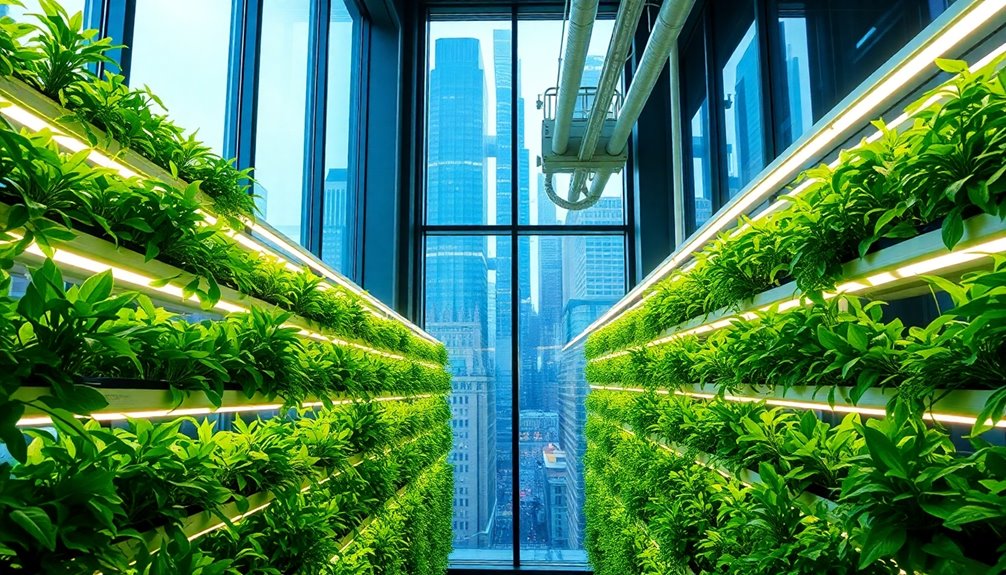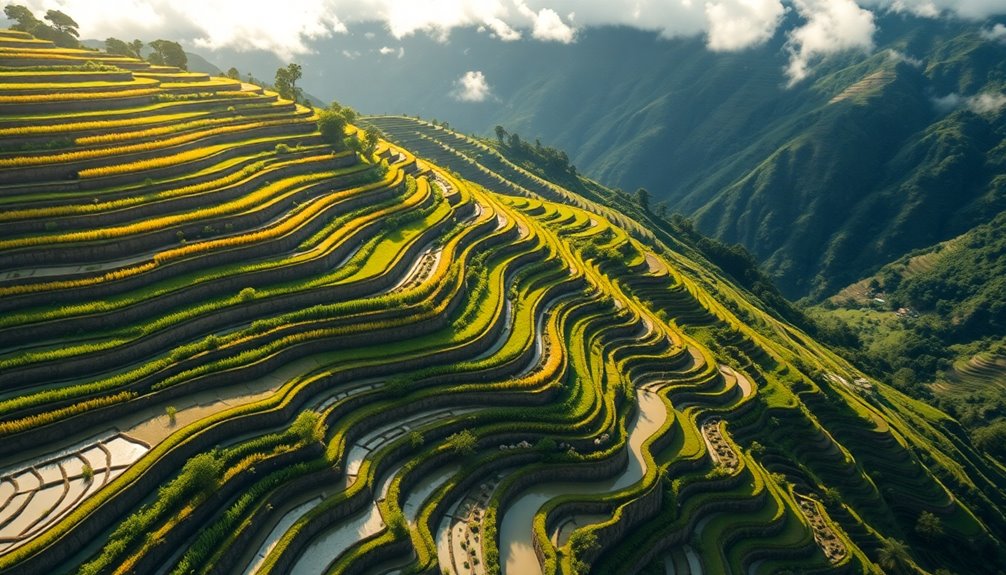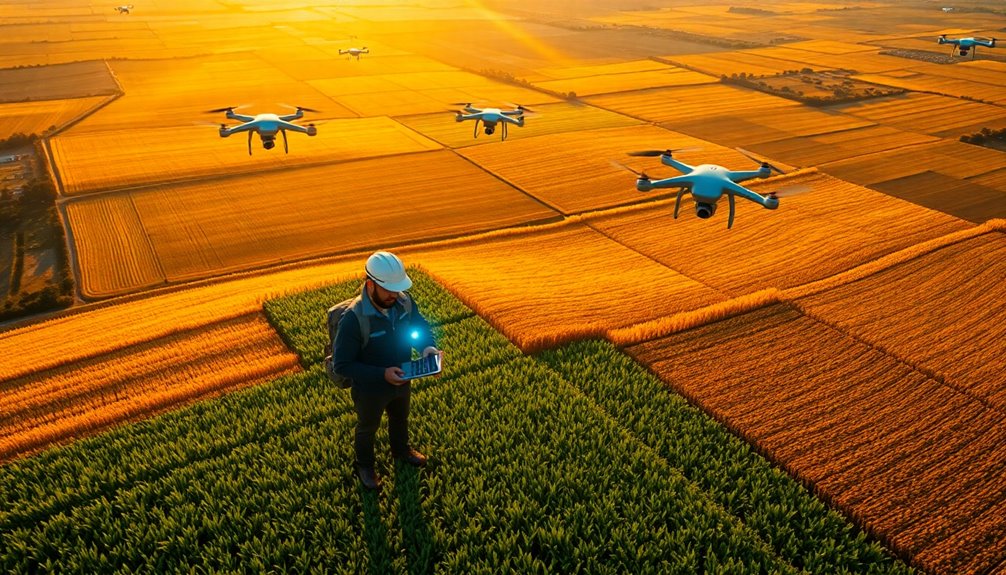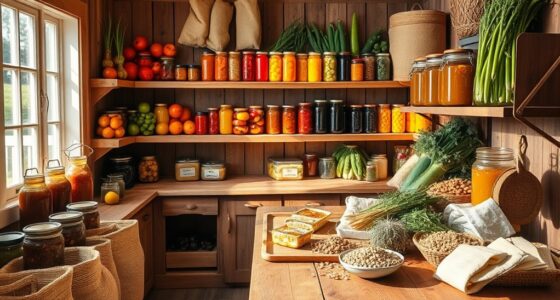Vertical farming revolutionizes urban agriculture by stacking crops in layers, optimizing space and efficiency. You receive fresh produce year-round by using hydroponics and advanced climate control systems that create ideal growing conditions. This method drastically reduces water use and environmental impact while providing local food, cutting transportation costs. It also minimizes pesticide use, ensuring healthier crops. With automation and data analytics, labor costs decrease and production reliability improves. As cities embrace this innovative solution, you'll see more job opportunities and economic growth in urban areas. Curious to discover how this technology continues to reshape agriculture?
Key Takeaways
- Vertical farming utilizes vertically stacked layers to cultivate crops, maximizing space and enabling food production in urban environments.
- It employs hydroponics, aquaponics, or aeroponics for efficient soil-less cultivation and nutrient delivery systems.
- Advanced climate control technology ensures optimal growing conditions, enhancing crop yields and reducing labor costs through automation.
- This method significantly decreases water usage and pesticide reliance, promoting sustainable and healthier food production.
- Vertical farming contributes to local economies by creating jobs and enhancing food sovereignty, while supporting urban greening initiatives.
Definition of Vertical Farming
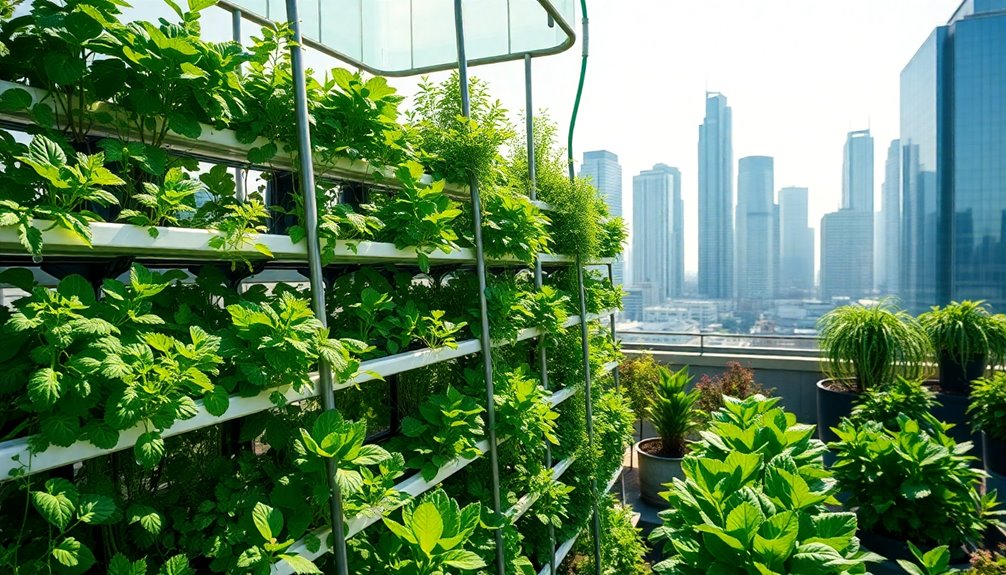
Vertical farming is revolutionizing the way we think about agriculture, especially in urban environments. This innovative method involves cultivating crops in vertically stacked layers, making it perfect for limited urban spaces like warehouses and skyscrapers.
By employing controlled environment agriculture, vertical farming optimizes conditions such as light, temperature, humidity, and nutrients to boost crop yields. Hydroponic systems, which allow plants to grow in nutrient-rich water solutions instead of soil, are commonly used in these setups.
The result? Yields that can be 50 to 100 times greater per square foot compared to traditional farming.
With resource use reductions of up to 98% less water and 90% less light energy, vertical farming offers a sustainable solution for food production in densely populated regions.
Mechanisms of Crop Cultivation

In the domain of urban agriculture, understanding the mechanisms of crop cultivation is key to maximizing the benefits of vertical farming.
Vertical farming utilizes hydroponics, aquaponics, and aeroponics, allowing you to grow crops without soil while enhancing nutrient delivery and water efficiency. Through controlled-environment agriculture (CEA) technology, you can precisely manipulate light, temperature, humidity, and nutrient levels, greatly enhancing crop yields year-round.
These farms can produce yields that are 50 to 100 times greater per square foot compared to traditional methods, making them space-efficient. Advanced climate control systems maintain ideal growing conditions, reducing energy costs and boosting productivity.
Automation and data analytics further improve efficiency in planting and harvesting, cutting labor costs by approximately 30%.
Environmental Benefits
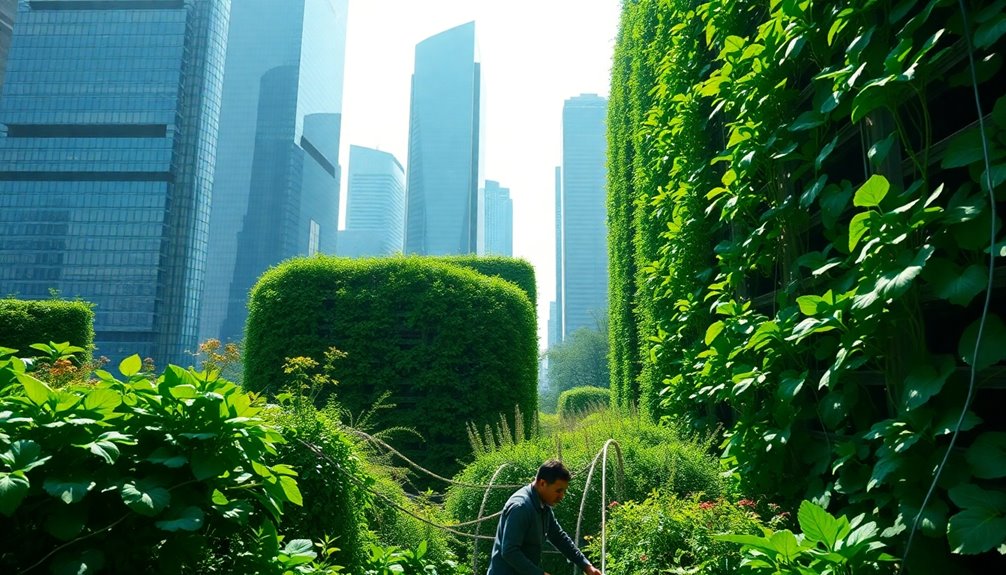
There's no doubt that vertical farming offers considerable environmental benefits that can transform urban agriculture.
By utilizing controlled-environment agriculture, you can markedly reduce water usage by up to 90%, conserving this essential resource. Vertical farming minimizes the need for pesticides, leading to healthier produce and less chemical runoff, which improves the ecosystem.
Additionally, growing food in urban areas cuts down on food miles, lowering carbon emissions related to transportation and contributing to reduced greenhouse gas emissions.
With efficient land use, vertical farms can produce 50 to 100 times more yield per square foot than traditional methods, promoting sustainable agriculture.
Plus, they enhance biodiversity and green spaces, helping to mitigate the urban heat island effect.
Health and Safety Aspects
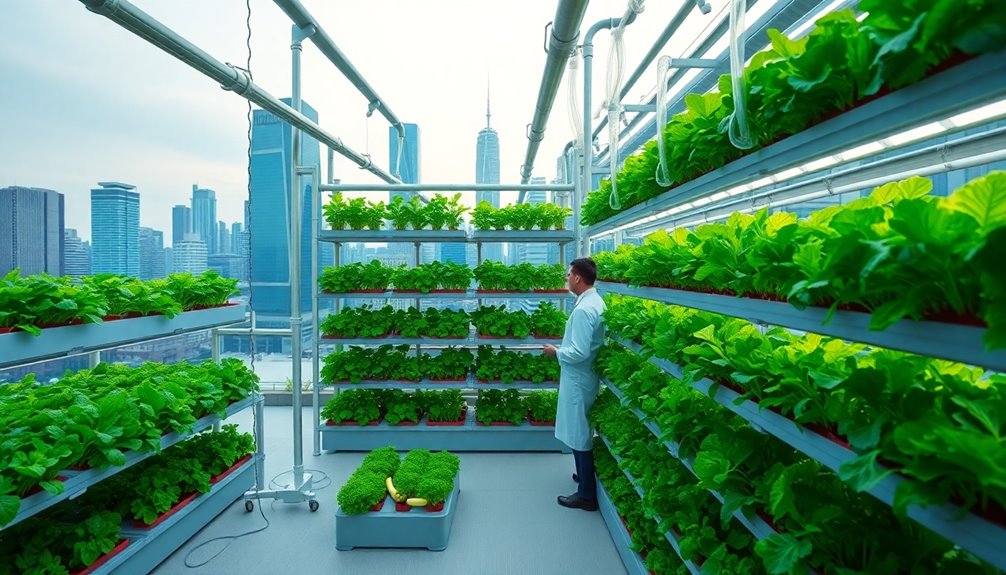
The environmental advantages of vertical farming naturally extend to health and safety aspects, making it a compelling choice for modern agriculture. By maintaining controlled conditions, vertical farming considerably reduces the risk of crop contamination, ensuring safer produce for you.
The absence of harmful chemicals, thanks to natural pest management, leads to healthier crops and minimizes pesticide-related health risks. Consistent monitoring for pathogens creates near-laboratory conditions, enhancing food safety and preventing farming diseases.
Additionally, vertical farms implement pesticide-free practices, reducing reliance on chemicals compared to traditional farming. This approach not only safeguards food production but also addresses public health concerns by minimizing occupational hazards and protecting crops from wildlife in urban spaces.
Production Efficiency

Over recent years, vertical farming has transformed the way we think about agricultural production efficiency. By maximizing limited urban spaces, it can yield 50 to 100 times more produce per square foot than traditional methods. An acre of vertical farming can equate to 10 to 20 acres outdoors, demonstrating remarkable space efficiency.
Utilizing hydroponic systems, these farms reduce water usage by up to 95%, contributing to significant resource conservation while ensuring high crop production levels. The controlled environment allows for year-round growth, eliminating seasonal limitations.
Additionally, automation in vertical farming can cut labor costs by around 30%, enhancing overall production efficiency and economic viability. This innovative approach is reshaping agriculture for the future, particularly in densely populated areas.
Technological Innovations

Harnessing cutting-edge technology, vertical farming revolutionizes urban agriculture by optimizing growing conditions and boosting crop yields.
You'll find that modern vertical farms utilize a mix of techniques to enhance efficiency, including:
- Hydroponics and aeroponics for soil-less growing
- Controlled environment agriculture (CEA) to regulate climate
- LED lighting systems that enhance photosynthesis while saving energy
- Automation and robotics streamline processes, cutting labor costs by around 30%
- Data analytics and precision farming to monitor health and optimize schedules
These innovations not only improve crop yields but also make vertical farming more adaptable through mobile and modular farming units, allowing for greater accessibility in diverse urban settings.
You'll see how these technologies are shaping the future of agriculture right in your city.
Future Outlook for Vertical Farming
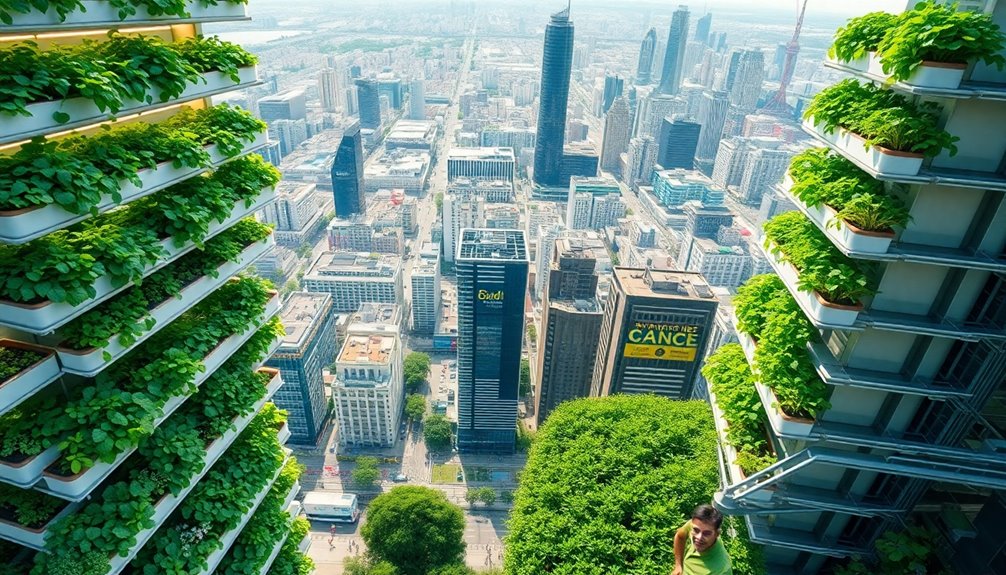
As you look ahead, the future of vertical farming is packed with potential thanks to rapid technological advancements.
You'll see how urban integration can transform food production and contribute considerably to global food security.
With innovative solutions on the rise, the landscape of urban agriculture is about to change dramatically.
Technological Advancements Ahead
With the rapid evolution of technology, vertical farming is on the brink of a revolution that promises to reshape urban agriculture.
You'll see advancements that enhance efficiency and sustainability, making it more viable than ever.
Key developments include:
- LED lighting that boosts plant growth while cutting energy use by up to 90%
- Automation and AI optimizing planting and harvesting, reducing labor costs by about 30%
- Hydroponics improving nutrient delivery for faster harvest cycles, some as short as 28 days
- Climate control systems ensuring ideal conditions for crop health
- Modular farming units allowing flexibility in diverse urban environments
These innovations not only promise to improve yields but also position vertical farming as a cornerstone of future urban food systems.
Urban Integration Potential
Recognizing the urgent need for sustainable food solutions, urban integration of vertical farming is set to transform how cities approach agriculture.
As urban populations grow, vertical farming can thrive in underutilized urban spaces like rooftops and abandoned buildings, enabling you to produce crops locally. This not only enhances food security but also reduces transportation costs and the carbon footprint associated with long-distance food distribution.
With innovative hydroponic systems, these farms can maximize efficiency while promoting sustainable agriculture practices. Collaborations between local governments and vertical farming initiatives will further bolster community access to fresh, local food.
The vertical farming market is expected to soar, projecting a robust future that aligns with urban integration goals and sustainable living.
Global Food Security Impact
Vertical farming holds the promise of revolutionizing global food security by delivering fresh produce directly to urban populations. This innovative approach addresses critical challenges in food accessibility and sustainability.
Consider these key benefits:
- Produces yields 50 to 100 times greater per square foot than traditional farming
- Guarantees year-round availability of fresh produce, combating climate change's impact on crops
- Utilizes 98% less water, promoting sustainable resource management in areas facing water scarcity
- Alleviates food deserts by improving access to healthy food options in urban areas
- Supports local food production, strengthening local economies
As the vertical farming market grows, projected to reach $12.77 billion by 2026, its role in enhancing food security becomes increasingly essential for urban populations worldwide.
Frequently Asked Questions
Is Vertical Farming a Sustainable Solution for Urban Agriculture?
Yes, vertical farming is a sustainable solution for urban agriculture.
It uses considerably less water and energy compared to traditional farming, allowing you to grow crops in a controlled environment year-round. This method maximizes land use, producing more food in smaller spaces, which is perfect for dense cities.
Plus, without chemical pesticides, you're getting healthier produce while reducing transportation emissions by sourcing food locally.
It's a win-win for sustainability and food accessibility!
How Will Vertical Farming Change Agriculture?
Did you know that vertical farming can yield 50 to 100 times more food per square foot than traditional methods?
This innovative approach will change agriculture by maximizing space in urban settings, reducing water usage by up to 98%, and minimizing transportation costs.
You'll see fresher produce with fewer pesticides, which enhances public health.
As cities grow, vertical farming offers sustainable solutions, addressing food security while promoting local economies and healthier lifestyles.
What Impact Can Vertical Farming Have in Metropolitan Areas?
Vertical farming can greatly improve metropolitan areas by maximizing food production in limited spaces.
You'll notice that these farms can grow 50 to 100 times more food per square foot than traditional methods, tackling food scarcity.
Plus, they use up to 98% less water, perfect for urban settings.
With fresh produce grown close to home, you'll see reduced transportation costs and carbon emissions, boosting sustainability and food security in your city.
How Does Vertical Farming Save Space?
Did you know that one acre of vertical farming can yield as much produce as 10 to 20 acres of traditional farming?
Vertical farming saves space by utilizing vertically stacked layers for crop growth. Instead of spreading out, you're maximizing every inch of available area.
Techniques like hydroponics and aeroponics allow crops to thrive in limited spaces, turning underutilized urban areas into productive farms and ensuring you get fresh produce right where you live.
Conclusion
Ultimately, vertical farming is reshaping urban agriculture with its innovative approach. Did you know that it can produce up to 10 times more food per square foot than traditional farming? By maximizing space and reducing resource use, it's not just about growing more; it's about growing smarter. As technology continues to advance, the future looks bright for vertical farms, making fresh produce more accessible while helping to combat environmental challenges in our cities.

